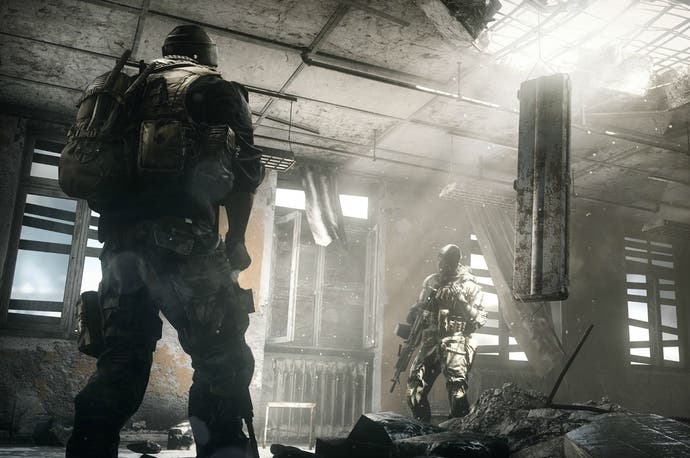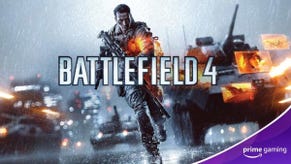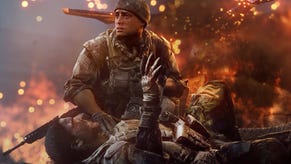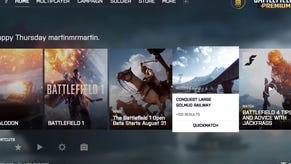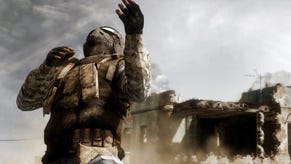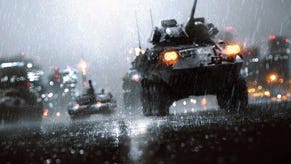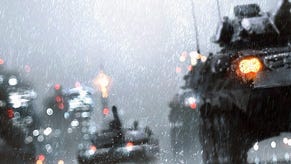The thrills and disappointments of the Battlefield 4 beta
Shanghaied.
I want to see the skyscraper fall down, but I just keep missing it. One moment it's there, a gleaming, glass and chrome monument to capitalism right at the centre of Battlefield 4's Siege of Shanghai map. Then, inevitably, I get bored, killed, distracted, wander off in order to capture a flag, or - if I'm feeling particularly brave - commandeer a tank, and when I get back to check in on the towering building, well, the skyscraper's already gone.
Don't get me wrong, I'm not a complete failure: I caught the dust cloud once. A huge, billowing mass of debris and particles that seemed bigger than the skyscraper itself, and also intensely evocative of real-life disaster footage. But the actual moment it falls keeps eluding me. Once, I was manning a gun turret in helicopter, circling the colossal structure as it (I think) slowly started to tilt, wrenched itself off its foundations and collapsed into the waters below. Sadly, the turret I was manning was on the wrong side of chopper.
It's pretty frustrating, really. I want to see the Siege of Shanghai's centrepiece, a terrifically huge, destructible structure, fulfil its gimmicky raison d'etre. But of course, my repeated failure to see it happen also brilliantly sums up what Battlefield does so well: its jaw-dropping blend of scale and spectacle. In how many other games can an entire skyscraper fall over and yet somehow I miss it, every single time?
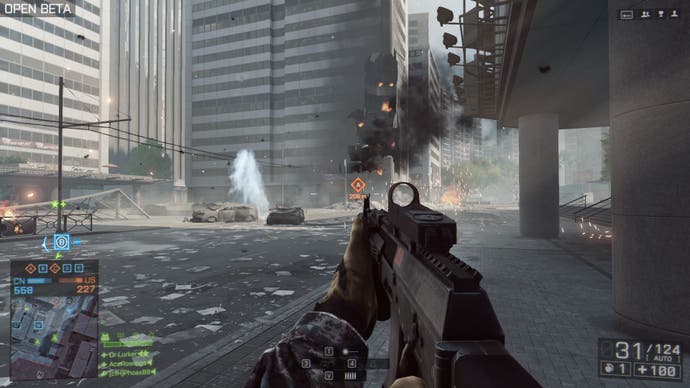
Played in Conquest mode, Siege of Shanghai is a huge map - and unstable architecture aside, it's actually a rather bland one. Perhaps it's due to the beta's work-in-progress nature, but everything feels rather grey and washed out in detail. Though like Battlefield 3, it'll probably look richer with an HD texture pack installed. Even for a beta, meanwhile, it's technically rather unstable too, with the frame-rate occasionally plummeting no matter what I do to the settings. Perhaps it's that skyscraper plummeting to the ground, off-screen.
The uninspired looks and sprawling scale have been offset for with some straightforward, easily understandable design. Siege of Shanghai is huge, naturally, but it's also rather simple: basically an inverted U with a water filling its middle and capture points along each arm, with the final capture point set upon the skyscraper at the top of the map. Until it falls over, anyway - then the capture point moves onto to an island formed out of rubble in the water.
The effect on the map is genuinely transformative: a sterile, near future city turns into, well, a warzone when that building falls: the dust cloud spreads through the map like gas, ruining sightlines and bringing a thick air of catastrophe to Shanghai, an atmosphere naturally enhanced by the destruction wrought by players themselves across the more obscure corners of the map. What starts off as clean streets, windows and rows of orderly columns ends up a flaming pit of rubble and debris by the end of most matches, courtesy of C4, helicopter strafing runs and tanks taking pot-shots at infantry cowering in the lobbies and storefronts.
I hesitate to make the comparison, but it's a valid one: the transformation in Call of Duty: Ghost's Strikeout, which essentially flips in an instant from its intact form to a derelict version of the map when a specific streak reward is called in, feels rigid and proscribed by comparison. If destruction is anything, after all, it's unpredictable and chaotic.
It's not the collapsing tower block that gives the map a dash of character and makes it seem more than a sterile, Shanghai-themed arena - it's the tiny, almost amusingly trivial details. Working lifts that take you to very top of the skyscrapers, for instance, adding a moment of surreal, workaday mundanity to gunfights (no muzak, sadly). These seem particularly true-to-life in that I inevitably end up facing the wrong door when they open, only to find myself shot in the back the moment we reach the top floor. Less obvious but much more amusing, if you want to slow the progress of enemy vehicles, are working bollards at the end of each of the bridges. These tiny bits of interactivity add genuine tactical wrinkles to on-foot encounters that go beyond distribution of cover.
I play my first few games cautiously as a Support class doggedly defending a single capture point set atop a car pack, and it's here the open, urban nature of the map starts to chafe. Snipers are lethal, obviously, especially when they've perched themselves atop one of the skyscrapers that stay rigidly rooted to their foundations whatever happens, and vehicles can take advantage of all the open space. This isn't a flaw with the map, per se, just a limitation of the beta: I've tended to rely on the Recon and Assault classes, with their better ability to handle long distance combat, so far.
It doesn't help that Battlefield 3's suppression mechanic has also been significantly downgraded. Well, nerfed. Well, practically eliminated. It's a real pity that a game that's supposed to replicate the feel of engaging in tactical combat in an actual warzone should feel the need to remove a mechanic that added a genuine strategic layer to squad-based play, but I guess it's a reflection of Battlefield's need to compete with Call of Duty's precise, skill-based combat. The Support class's LMG does still have a more pronounced suppression effect that any other weapon: but that effect isn't quite the debilitating experience it once was. It's merely visual rather than genuinely accuracy-affecting, and that means that you can still return fire when suppressed. Well, a skilled player can, but I'm a terrible shot. And that's precisely why suppression was useful: it meant less skilled players still had a tactical role to play when it came to squad-based combat: suppressing the enemy while their more accurate allies flanked them and took them out.
Of course, if you prefer your encounters to be decided purely by quickness of reflexes and sureness of aim, you'll definitely enjoy the weapon handling here. It's a crisp, precise refinement on Battlefield 3's, that should be further enhanced by the breadth of customisation options. These seem sprawling, though I'm yet to unlock enough to truly start truly experimenting.
As betas go, this is still weirdly encouraging. Weird because the map itself is a disappointment, and a strange choice to lead with: collapsing skyscraper and interactive bollards aside, Siege of Shanghai lacks personality. But encouraging because the increased focus on environmental interactivity coupled with Battlefield's robust core systems and unrivalled scale still offer triple-A gaming's best compromise between tactical breadth and immediate thrills. These are battlefields that feel like battlefields - large, and sprawling, and where you and your squad are just a tiny part of a larger war.
